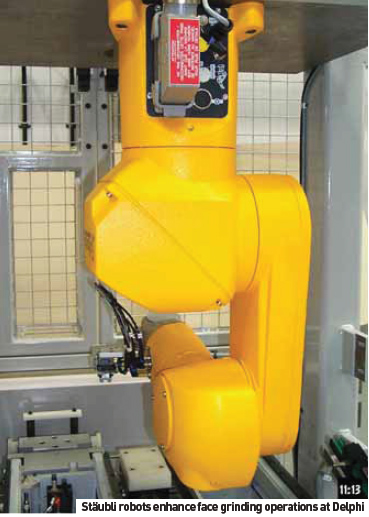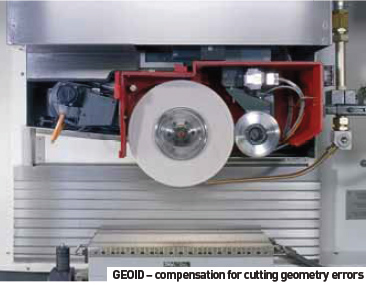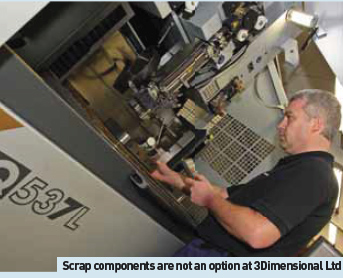With hardened parts increasingly being called on to provide the long service lives demanded by consumers, ways to improve the efficiency of hard turning and grinding processes are high on the agenda for many automotive manufacturing engineers. Auto components such as bearings, transmission gears, injector nozzles, shafts, pinions and cams are frequently machined from materials in the 58-68 HRc range. The trick is to boost productivity and reduce costs without affecting the quality of hardened parts, many of which specify demanding geometric tolerances when finish-machining after hardening. Here are some companies which offer such solutions:
With both processes offering specific advantages, selection in some instances has come down to ease of automation. For example, one application  where the use of multi-axis robots has brought significant advantages is in the machining of injector valves at Delphi Diesel Systems. Douglas Curtis Machine Tools was commissioned by Delphi to improve the production rates for these components at both the Sudbury, UK factory and in La Rochelle, France. The required operation was to extract part-machined components from the input pallet, precision gauge (to submicron levels), present to a Supfina face grinding machine, unload, deburr and re-palletise, all within the grinding cycle time.
where the use of multi-axis robots has brought significant advantages is in the machining of injector valves at Delphi Diesel Systems. Douglas Curtis Machine Tools was commissioned by Delphi to improve the production rates for these components at both the Sudbury, UK factory and in La Rochelle, France. The required operation was to extract part-machined components from the input pallet, precision gauge (to submicron levels), present to a Supfina face grinding machine, unload, deburr and re-palletise, all within the grinding cycle time.
Douglas Curtis investigated either adapting pick-andplace automation systems, or using multi-axis robots. The use of three Stäubli RX60 robots (two at Sudbury) provided a less-complex solution, requiring 50% of the floor space of the pick-and-place system, coupled with improvements in cycles times, quality levels and repeatability that was not achievable with any other system, says the company. The Stäubli robots can also incorporate changes in the operational sequence in response to design changes and product developments at Delphi.
• The trend of automated grinding continues with a success story from Studer, which recently announced that it had passed the milestone of 100 grinding systems sold with the company’s ‘easyLoad’ handling system. The hundredth unit went to Josef Rees of Wehingen, Germany – a sub-contract precision machine shop.
The easyLoad system can be combined with Studer machine types S21, S31, S36, S40, covering workpieces between 20 and 300mm in length, says the company. Adjustable conveyor belts or interchangeable pallets offer flexibility while also reducing set-up times. Studer is currently further developing the easyLoad concept so that additional machine types can be equipped for an increased workpiece spectrum.
• Continuing the theme, EWAG has just announced the launch of its Compact Line CNC grinding machine which features  an integrated robot system, with everything inside the machine positioned close to the working B-axis: travel ranges for axes and robots are therefore kept to a minimum, cycle and downtimes are shortened, with proportional increases in productivity.
an integrated robot system, with everything inside the machine positioned close to the working B-axis: travel ranges for axes and robots are therefore kept to a minimum, cycle and downtimes are shortened, with proportional increases in productivity.
• Similarly, the new six-axis Fanuc Robot Loader, announced by Körber Schleifring, further extends the flexibility of Walter Helitronic power grinders by allowing a range of different clamping devices to be used to handle a variety of workpieces.
Workpieces up to 280mm long and weighing 1.5kg can be quickly handled by the Fanuc six-axis LR Mate 200iC/5L robot and, coupled with the three-pallet system, give a storage capability of up to 1,500 workpieces (dependent on diameter), says the company. The Robot Loader further enhances the choice of loaders: Pallet-, Disc- and Eco-type. •With component complexity increasing as automotive firms look to consolidate parts into single-piece machinings, the need for greater contour precision at profile dressing has grown in direct proportion. The upshot is automatic diamond adjustment through software such as GEOID, a new development from Blohm-Jung.
Unwanted changes in contour form that occur during the grinding process are often attributed to the wheel losing profile. However, it can frequently be the result of plain diamond wear and is typically witnessed as a slow deterioration in profile. In these instances, the diamond can wear unevenly to give an unusual profile; this is where the GEOID system comes into its own.
 The topography of the cutting edge on a dressing tool is determined with micron-level precision by an automatic measuring sensor to produce a perfect contour on the grinding wheel. Contours are profiled on grinding wheels by single-profile diamonds or diamond dressing wheels with selected cutting edges. The dressing tools can have a variety of cutting radii to allow for different profiles to be formed. Typical radii are 0.125, 0.25 and 0.5mm, however these can vary as required.
The topography of the cutting edge on a dressing tool is determined with micron-level precision by an automatic measuring sensor to produce a perfect contour on the grinding wheel. Contours are profiled on grinding wheels by single-profile diamonds or diamond dressing wheels with selected cutting edges. The dressing tools can have a variety of cutting radii to allow for different profiles to be formed. Typical radii are 0.125, 0.25 and 0.5mm, however these can vary as required.
According to Blohm-Jung, because the cutting radius has a direct influence on contour precision, it should be regarded with extreme prudence. It may come as a surprise to learn that even new dressing tools can have a deviation of a few microns, while additional deviation can occur from abrasion during the dressing process. No matter how small the deviation, the profile geometry of the grinding wheel is affected directly, as is the workpiece. GEOID compensates automatically for errors on cutting radius, says the company. While in conventional terms the dressing tool is usually guided in an equi-distant manner, i.e. parallel to the set-point contour, in modern grinding, its actual path is optimised to take into consideration the cutting edge contour. Using GEOID, however, the user will not be aware of any of this. GEOID has already been integrated into Blohm-Jung’s established self-acting adjustment software PA37K, which the company says ensures the operator has no additional work to complete. The six-minute adjustment of a diamond star and 10 minutes for a diamond wheel is not affected.

The advantages of GEOID are that errors in cutting geometry are detected and corrected at the least deviation. Further deviations caused by abrasion are also detected and compensated for, while diamonds with slight abrasions that had to be corrected out in the past can now be used for considerably longer periods. Even at 30μm tool abrasion, a profile accuracy of < 5μm can be achieved, Blohm-Jung says. GEOID increases the durability of different dressing tools by more than 50% and tooling costs are reduced by the same ratio, adds the company.
• The latest automatic CNC grinding machines are providing automotive supply chain manufacturers with a range of innovative solutions. Case in point is ZF, a major supplier of assemblies such as drive and chassis systems, which has recently installed a number of Schaudt, Mikrosa and Studer cylindrical grinding machines.
Kuka reports that it has provided an automated post-forge grinding process for Brockhouse Group. The 150kg payload robot is part of a production cell being used to fi nish a range of steel forgings for customers in the off-road vehicle sector. The forgings, which can weigh from 2kg up to 80kg, are gripped by the robot from one of two workstations and then manoeuvred to a fi nishing belt for fl ash removal. Some parts are passed to the cell’s angle grinder unit for additional fi nishing operations.
Elsewhere, Peugeot in Valenciennes, France, has recently installed a Rösler shot peener using with spherical blast media to peen transmission parts. The system has a rotational double chamber with pneumatic seal and safety light curtain. This concept minimises time for material handling, says the supplier. While one part is peened automatically using four blast guns in the fi rst chamber, another part can be loaded/unloaded in the other, providing throughput of around 120 parts per hour.
At its factory in Friedrichshafen, Germany, ZF produces gear components such as wheels, shafts and special parts for bus and truck gearboxes. The parts are ground on Schaudt cylindrical machines, including two new CombiGrind VM and HL models, which ZF is hoping will produce appreciable improvements in process safety and cycle times.
At ZF’s plant in Shanghai, the company manufactures hydraulic steering units for the Chinese and other regional markets. Here, the company grinds the external diameters of rack shafts and pinions on two Mikrosa Kronos LX machines, and on Studer S30, S36 and S40 models that are customised to requirements.
Studer machines also play a key role at ZF’s facility in Schwäbisch Gmünd, Germany, where electronic steering systems represent the core business. The company produces a range of steering components, including one that is relatively new: the steering nut for an axle-parallel drive. Until recently, the company was producing 2,000 units a day, but future volumes are expected to rise to two million parts annually. An essential step in the production of the steering nuts is the grinding process, performed on a Studer S12. In combination with CBN grinding wheels, cutting speeds far in excess of 50m/s are reached to help reduce cycle times. More often than not, automotive components demand special technology. In the case of camshafts, Junker, one of China’s largest auto producers, has just ordered five of its grinding machines for the complete processing of these complex components.
Using two Jupiter 500 centreless grinding machines, the bearings and journals undergo initial and final grinding in a plunge grinding process. The geometry of twin cams with multiple wheels is ground using two Jucam 6LS machines for non-circular processing, while the shaft ends are produced using an EJ31 external cylindrical grinding machine. • Turnkey solutions are also in demand, with Curtis Douglas Machine Tools reporting a German order for two cells to manufacture turbocharger shafts. The cells will each include two CMT Vector twin-spindle cylindrical grinding machines, a burnisher and units for deburring, superfinishing and washing, as well as incorporating a laserbased final inspection system.
Hard done by
The trend towards hard turning is driven by grinding’s sometimes prohibitively expensive tooling, costly support equipment (balancers and dressers), and lengthy set-up times. With the latest single-point hard turning processes able to deliver 5μm size repeatability, roundness of 0.38μm and 0.1Ra surface finish, it is easy to see why many have dropped cylindrical grinding.
However, successful hard turning relies on achieving a finely-balanced process. Machine rigidity dictates the degree of hard turning accuracy. Keeping this in mind, a turning machine with inherent rigidity is essential to accommodate cutting pressures that can be double that of conventional turning operations.
• Machine tool specialist Hardinge has integrated several features in its latest high-performance CNC lathes to increase rigidity and damping characteristics for hard turning. These include machine bases offering polymer composite reinforcement combined with widely-spaced, heavy-duty linear guides, direct-seating colleted spindles that locate the spindle bearing near to the component, and hydrostatic ways. Also, super-finished tracks and centrallylocated, short-pitch ballscrews provide high dynamic stiffness, which helps reduce vibration and minimise stick/ slip movement, says the company.
One manufacturing process where hard materials cause no problem is electro discharge machining (EDM). Whether the process is an effective substitute for hard turning or grinding depends very much on the application. For companies such as 3Dimensional, manufacturer of pressure die cast tooling for the automotive sector, EDM is ideal. Based in West Bromwich, UK, the company is using its newly-installed Sodick AQ537L linear motor wire EDM to reduce the number of set-ups (from fi ve, to one) required for a number of its larger tooling inserts. Around 80% of revenue at 3Dimensional is driven by the automotive sector. Companies supplied include Aston Martin, Borg Warner, BMW, Dura, Ford (Germany), GM, Land Rover, Nissan, Perkins, Renault, Saab and Toyota. Although the company deals mainly with Tier One foundries, 3Dimensional has to liaise directly with OEMs. Key to these relationships is the ability to demonstrate best-practice manufacturing, says the company. “Until recently, we operated a wire EDM with a small working area of 320 x 220mm,” explains Managing Director Jason Callaghan. “As we make die-casting tools up to 15 tonnes in weight, some of the inserts are quite substantial. Using our small EDM would sometimes require four or fi ve re-positions to get a job fi nished. However, with our Sodick AQ537L, which has a working area of 600 x 570mm, we can leave a job running unattended overnight, safe in the knowledge that one setup is enough to fi nd it complete in the morning.” Installed in late 2009, the Sodick AQ537L has been set to work producing large pressure die-cast tooling inserts, most of which are populated with a high number of deep holes that accept mating components such as ejector pins. Manufactured typically from H13 tool steel up to 50HRc, and with certain billets costing up to £5,000 ($7,500) each, scrap is not an option, even though tolerances can be as tight as 0.012mm. Sodick has recently raised the productivity stakes, offering a 7-axis ‘turn and burn’ EDM die-sink solution controling the movement of a twisted electrode so that it penetrates the workpiece in a corkscrew-like motion – an frequent requirement in automotive applications.
According to Hardinge, the linear guideways on its RS high-performance lathes are typically 40 - 60% heavier-duty units than those fitted to most machines of comparable size. The patented spindle design on Hardinge RS and Quest GT series lathes ensures that the workpiece is seated as close as possible to the spindle bearings for maximum rigidity and accuracy. This greatly improves the hard turning process compared with competitive workholding solutions, says the company.
Even though hard turning consists of small depths of cut and relatively low feed rates, the process can offer metal removal rates up to six times higher than grinding (depending on application). Hardinge says there are many additional advantages associated with turning hardened materials, including: single-point turning of complex contours eliminate the need for costly form wheels; multiple operations machined in a single set-up reduce part handling and possible part damage; and reduced machine tool cost - increasing productivity and production control, with shorter throughput and greater profit.
RF improvements
The higher the resonant frequency (RF) of a machine tool’s structure, the greater its inherent stiffness and the more difficult it is for machining forces to induce vibration. • With this in mind, German CNC lathe builder Index has re-designed its patented SpeedLine C-type turn-mill centres to increase RF measurements above that of similar lathes on the market, including existing models in its own range. Index says that using the RF measure, the new C-type turning machines are over twice as stiff (rigid) as the established Index G-series models of equivalent capacity. This means that there is more latitude for finding the ‘sweet spot’ for any combination of toolholder, cutter and workpiece, allowing depth of cut to be increased for maximum metal removal rate. High rigidity and the lowering of machine tool vibration also ensures good surface finish of the machined part, prolonged tool life and reduced noise. Better damping leads to higher accuracy machining, even for strenuous applications involving intermittent hard turning and reaming.
The defining characteristic of the Index lathes that provide such high RF and stiffness hinges on the actuation of the turrets, says Index. Each is mounted on a front plate, while an interconnected rear retaining plate is driven kinematically from behind the machine bed. The critical advantage of the sliding plate system is that the distance between the turret centreline and the point at which it is driven is much shorter than for a compound slide. The turret and drive plates are fitted with ceramic-coated, hardened tool steel strips at top and bottom that slide over a third plate of surface-hardened cast iron fitted into the bed, the latter plate being effectively sandwiched between the other two.
The parallel kinematic drive to the rear plate is now effected by two (rather than the previous three) ballscrewactuated rods at the back of the machine, one vertical and one horizontal, notes the company.
• Elsewhere, the rigidity, power and tooling design of a MAG Giddings & Lewis VTC-series vertical turning centre also makes it an increasingly popular choice for hard turning operations, says the company. The VTC table bearing design and hydrostatic ram offer a rigid machining platform with good damping characteristics, while the 75-108kW motors produce the horsepower needed for hard turning.
• Finally, WedgeLock says the 150kN clamping force and large-gauge diameter of its tooling system produces a sturdy, rigid connection between the tool and ram.


































